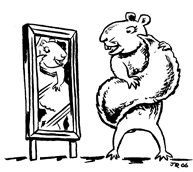Ask an expert: Getting squirrelly
Ask an expert: Getting squirrelly McGill University
User Tools (skip):
Ask an expert
Getting squirrelly
Why do squirrels have such luxuriantly bushy tails? Surely it must serve some evolutionary purpose other than giving its predators a nice big handle to latch onto.
Victor Chisholm
Undergraduate Research Officer
McGill Faculty of Science
David M. Bird, Ph.D., Professor of Wildlife Biology, Department of Natural Resource Sciences, Macdonald Campus, responds:

Jack Ruttan
Ah, the "luxuriantly bushy tail" of the grey squirrel! As aesthetically beautiful as they are, they are indeed multi-functional. Not only do those tails serve as a balance (and occasionally as a parachute) for the squirrels' acrobatic branchwork, and as a rudder during their infrequent swims, they also act as a sunshade in the summer, a warm bodywrap on chilly days, and an extremely useful sensor for detecting air currents that indicate changes in weather or the entrances to holes. Best of all, their tails can be flicked about in various ways to warn others of the extent of the squirrel's ill humour when kept out of bird feeders for instance. Let's be truthful though. If our grey squirrels had fur-less tails reminiscent of those of Norway rats, I'd be willing to bet that humans would take a much dimmer view of them.
Got a question? Email neale.mcdevitt@mcgill.ca.

